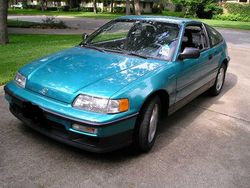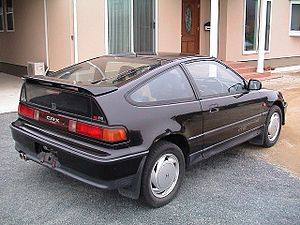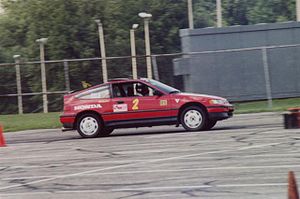- Honda CR-X
-
This article is about the first and second generations of the CR-X. For the third generation, see Honda CR-X del Sol.
Honda CR-X Manufacturer Honda Production 1983–1991 Successor Honda CR-X del Sol Class Sport compact Body style 2-door hatchback Layout FF layout Transmission 4-speed automatic
5-speed manualRelated Honda Civic
Acura Integra
Acura RSX
Honda CR-ZFirst generation 
Production 1984–1987
Chassis EC1 AF AE532Engine 1.3 L 58 hp I4
1.3 L 60 hp EV1 I4 (1984–1986)
1.5 L 58-76 hp
EW1/D15A2 I4 (1984-85)
1.5 L 91 hp EW3/4 I4 (1985-87)
AU/NZ Spec:
1.5 L 108 hp
EW5/D15A3 I4 (1985–1987)
1.6 L 135 hp ZC1/D16A1 (1986–1987)Second generation 
Production 1988–1991 Engine US Spec:
JDM/EU-spec:
1.5 L 62 hp D15B6 I4 (1988-89)
72 hp D15B6 I4 (1990-91)
1.5 L 92 hp D15B2 I4
1.6 L 105 HP D16A6 I4 (1988)
1.6 L 108 hp D16A6 I4 (1989-91)
1.4 L 90 hp D14A1 I4
1.6 L 136 hp I4
1.6 L 130 hp D16A9 I4
1.6 L 140 hp D16ZC I4
1.6 L VTEC 150 hp B16A1 I4Wheelbase 90.6 in (2,301 mm) Length 148.5 in (3,772 mm) (1990-91)
147.8 in (3,754 mm) (1988-89)Width 65.9 in (1,674 mm) (1990-91)
65.7 in (1,669 mm) (1988-89)Height 50.1 in (1,273 mm) (1990-91)
50 in (1,270 mm) (1988-89)The Honda CR-X, originally launched as the Honda Ballade Sports CR-X in Japan, was a front-wheel-drive sports compact car manufactured by Honda. The first generation CR-X was sold in some regions outside Japan as the Honda Civic CR-X. At its introduction, the CR-X was available in Japan only at Honda Verno dealership sales channels, and accompanied the Vigor, the Quint, and the Prelude.
In the US-spec, the CR-X was marketed as an economy sport hatchback, having room for just two passengers. EU-spec, however, received a ZC 130 hp (97 kW) engine and 2+2 seats. Redesigned in 1988 and produced to 1991, the CR-X was popular for its performance, nimble handling, and good fuel economy. In the US its performance model, the Si (with the SOHC (D16A6) not the equally-sized JDM Si 1590cc (ZC) DOHC engine), was a favorite. Honda's 1992 CRX del Sol was marketed as a CR-X in some markets.
The original 1.3 liter car (chassis code AE532) and the later 1.5 liter American-market CR-X HF (High Fuel economy) model (chassis codes EC1 and AF) could reliably achieve very good gas mileage, more than a decade before gas-electric hybrids appeared on the market, and at no price premium over the base model; the 1.5 liter is rated by the U.S. Environmental Protection Agency (EPA) (under the new rating system) at 41 miles per U.S. gallon (5.7 l/100 km; 49 mpg-imp) city and 50 miles per U.S. gallon (4.7 l/100 km; 60 mpg-imp) highway.[1] The Japanese Si and European 1.6i-16 models came with a 1590 cc DOHC engine putting out 135 bhp (101 kW; 137 PS) in the UK-spec model and 140 bhp (104 kW; 142 PS) in the JDM model. Though similar versions of the same engine, the Japanese Si engine was stamped ZC, whilst the European engine was stamped D16A9.
The chassis was significantly changed in 1986 from its original torsion bar front and semi-independent rear, to fully independent wishbones all around in line with its sister Civic/Ballade models. Outside of North America, this generation 2 CR-X was available with a 1495 cc sohc or an updated version of the 1590 cc DOHC ZC engine. Many of these were fitted with fuel injection as standard.
In September 1989 Honda also added the 1595 cc B16A VTEC engine to the lineup outside of America. The VTEC engine used Variable Valve Timing to provide increased power in the high rev range, while still allowing low fuel consumption and better idling at low RPMs. The B16A produced 150 bhp (112 kW; 152 PS) in the European 1.6i-VT model (where the engine bore the designation B16A1) and 157 bhp (117 kW; 159 PS) in the JDM SiR model. The CR-X was the second car to receive a VTEC engine, shortly after the Integra, although the CR-X was more popular and common.
The VTEC-equipped models also received a makeover, with updated bumpers, lights, bonnet/hood, brakes, suspension and dashboard design amongst other things. Additionally, some of these design changes were added to the concurrent non-VTEC models.
One of the options for the Japanese Domestic Market (JDM) CR-X was a glass roof, a fixed glass panel which stretched from the top of the windshield to the top of the hatch opening. Relatively common in Japan, these are sought-after models in other markets.
Second-generation CR-Xs in the US could choose between three different trim levels: The standard (unlabeled, sometimes called the "DX") with the 16-valve 1495 cc "D15B2" engine and Dual-Point Fuel Injection (DPFI), the HF ("High Fuel efficiency") model with the 8-valve 1495 cc "D15B6" engine and Multi-Point Fuel Injection (MPFI), or the Si (Abbreviation in debate) model with the 16-valve 1590 cc "D16A6" engine and MPFI. "DX" models were available with an automatic transmission, all others had five-speed manuals. The Si models all came with a power sliding moonroof.
In 1992, Honda replaced the CR-X with a new, Targa topped, Civic-based model called the Honda Civic del Sol, otherwise known as simply the Honda del Sol. The del Sol was also badged as the CR-X del Sol in some markets, and known as simply the CR-X in others. It is because of this that the del Sol is generally considered the "3rd Generation CR-X" among enthusiasts, although it was arguably a very different car and Honda had seemingly quite different design goals when they built it[citation needed]. In the United States, the del Sol came in three trim lines: S (VXi in Japan, later VGi), Si (ESi in Europe), and VTEC (SiR in Japan and VTi in Europe) ; the 1994-1997 models featured a 160 hp (120 kW) DOHC VTEC-engine. Production of the del Sol ended in 1997, and thus, the CR-X line was retired.
Articles on the CR-X have compared its appearance to that of the Honda Insight.[2][3]
Previous rumours of a CR-X comeback involved the Honda REMIX concept, which was presented at a Los Angeles International Auto Show. Designer Ben Davidson denies that any design elements were taken from the CR-X and Honda also claims there are no production plans for the REMIX; it was simply a design exercise.
Contents
Awards
The CR-X was Motor Trend's Import Car of the Millenium for 1990. It also made Car and Driver magazine's Ten Best list for 1985. The redesigned CR-X was on Car and Driver magazine's Ten Best list for 1988. The CR-X Si was Motor Trend's Import Car of the Year for 1988. The 1988 CR-X Si was named one of Road & Track's 10 Best Cars of All Time.
Safety
In Australia, the 1988-1991 CR-X was assessed in the Used Car Safety Ratings 2006 as providing "significantly worse than average" protection for its occupants in the event of side impact.[4] On the other hand, both versions of the CR-X got good safety marks (5 and 4 stars) in the NHTSA Crash Test Results For 1997 US NCAP[5]
The U.S. version of the second generation CR-X employed the use of side impact door beams on some models. These models can be identified by the mounting position of the safety belts. If the belt is mounted in the door, the beams are present. If the belt is mounted in the body, there is no additional reinforcement.[citation needed]
USA
The National Highway Traffic Safety Administration (NHTSA) in the USA has determined frontal crash test ratings of Honda CRX of different model years.[6]
Model year Make Model Type Curb weight (lb) Frontal driver rating Frontal passenger rating 1984 Honda Civic CRX 1,882 

1989 Honda Civic CRX 2,310 

USDM Curb Weights
DX HF Si Manual Manual Manual 1984 1,819 lb (825 kg) 1,713 lb (777 kg) - 1985 1,819 lb (825 kg) 1,713 lb (777 kg) 1,883 lb (854 kg) 1986 1,819 lb (825 kg) 1,713 lb (777 kg) 1,953 lb (886 kg) 1987 1,865 lb (846 kg) 1,713 lb (777 kg) 1,978 lb (897 kg) 1988 1,922 lb (872 kg) 1,819 lb (825 kg) 2,017 lb (915 kg) 1989 2,048 lb (929 kg) 1,834 lb (832 kg) 2,075 lb (941 kg) '90-'91 2,103 lb (954 kg) 1,967 lb (892 kg) 2,174 lb (986 kg) Motorsport
Like the Civic, due to the wide availability of parts, the CR-X is popular for motorsport usage. In the United Kingdom, there was a one-make series dedicated to the series 2 of the CR-X[7] which soldiered on a few years after the series 3 was introduced and was popular for showroom stock racing series. Nowadays, the car is popular for drag, autocross, and road racing events.
Notes
- ^ Gas Mileage of 1989 Honda Civic CR-X HF, fueleconomy.gov website
- ^ "Inside Line: News, Road Tests, Auto Shows, Car Photos and Videos". Edmunds.com. 2009-01-22. http://www.edmunds.com/insideline/do/Drives/FullTests/articleId=139246. Retrieved 2011-10-02.
- ^ Adrian Akau (2010-12-24). "2010 Honda Insight world premiere". Gizmag.com. http://www.gizmag.com/2010-honda-insight-world-premiere/10762/. Retrieved 2011-10-02.
- ^ "Safety Report". www.howsafeisyourcar.com.au. http://www.howsafeisyourcar.com.au/_scripts/ucsr_search_result.php?IID=15124. Retrieved 2011-10-02.
- ^ "Archived NHTSA crash test results from". Crashtest.com. http://www.crashtest.com/explanations/archive/crash.htm#anchor359532. Retrieved 2011-10-02.
- ^ "NHTSA Crash Test Results For 1997 US NCAP". SafeCarGuide.com, Inc.. http://www.safecarguide.com/exp/archive/archive.htm#anchor359532. Retrieved January 2, 2009.
- ^ "Mardi Gras Motorsport: Company History". Mardigras.co.uk. http://www.mardigras.co.uk/htm_files/history.htm. Retrieved 2011-10-02.
External links
- 1988 Honda CR-X Brochure,(1987), p. 21-22.
- 2nd Gen Honda CR-X Brochures (US,UK,Holland)
- 2nd Gen Honda CR-X Specifications (European and JDM)
- Honda Press Library - CRX series - official library of original press information and "fact books" on all of the CRX series (in Japanese, though contains many images including concept artwork)
- [1] - Article on the CR-X
Categories:- Honda vehicles
- Honda Civic
- Front wheel drive vehicles
- Front wheel drive sports cars
- Vehicles introduced in 1983
- Hatchbacks
- Sport compact cars
Wikimedia Foundation. 2010.



